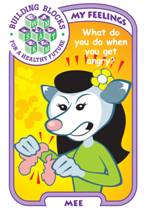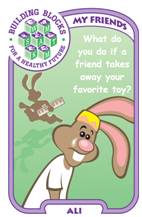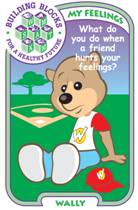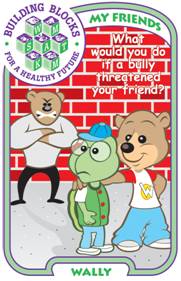 Together, talk about the picture on the card. How does Mee Possum look? How is she acting out her feelings?
Together, talk about the picture on the card. How does Mee Possum look? How is she acting out her feelings?
It’s never too early to make sure that your child knows he or she can always come to you with problems. The best way to open these lines of communication is for you to begin the conversation. These early conversations will ensure that your child will feel comfortable talking about any topic with you.
Unfortunately, sometimes it is difficult to know exactly what to say. Building Blocks for a Healthy Future Know Kit Cardsfor children ages 3 to 4 and 5 to 6 provide questions, tips, and hints for starting a meaningful conversation.
Helpful Know Kit Cards
Samples for Ages 3–4
 Together, talk about the picture on the card. How does Mee Possum look? How is she acting out her feelings?
Together, talk about the picture on the card. How does Mee Possum look? How is she acting out her feelings?
Next, use the questions on the card to guide your child to identify and deal with angry feelings.
Then ask how it feels if someone talks angrily to him or her—shouting, name calling, or teasing. This question helps in two ways. First, it allows your child to understand how it feels when someone is picking on him or her; and, second, it helps your child understand the feelings of others who are being picked on.

Together, talk about the picture on the card. What happened? How does Ali Rabbit feel? How do you know?
Next, use the questions on the card to guide your child to talk about how Ali might get his toy back. Talk about sharing, but remember sharing does not mean missing your turn to play with the toy.
Then ask your child to talk about a time when someone took away a favorite toy. Talk about his or her feelings at the time. Talking about how your child felt when this happened can help prevent him or her from taking someone’s toy.
Samples for Ages 5–6
 Together, talk about the picture on the card. How does Wally Bear feel? What might have happened?
Together, talk about the picture on the card. How does Wally Bear feel? What might have happened?
Next, use the questions on the card to guide your child to talk about hurting someone’s feelings. What actions or words have hurt your child’s feelings in the past? How did he or she handle the situation? What else could have been done?
Then ask your child to look at the picture again. Talk about how to help Wally. What kind words would your child say? What actions might he or she take?
 Together, talk about the picture. What might have happened? Who is being threatened? Who is helping? How can you tell? What is a bully?
Together, talk about the picture. What might have happened? Who is being threatened? Who is helping? How can you tell? What is a bully?
Next, use the questions on the card to guide your child to talk about bullying and whether he or she has ever been bullied.
Then have your child talk about being an onlooker or the friend of a child who is being threatened. What could he or she do to help?
Whenever you need a little help getting a conversation going with your child, get out the Know Kit Cards.You may choose to pick a card that focuses on something you have in mind or let your child pick out one that he or she finds interesting or appealing. Use the cards to build your child’s confidence, build vocabulary needed to express his or her feelings, and help your child work and play better with family and friends.
Remember, if you have any concerns about your child’s unexpected change of behavior, talk with his or her teachers to see if any changes have occurred in the classroom. Talking early allows teachers to be aware of any issues and be prepared to make classroom adjustments immediately, if necessary.
For more help with bullying, click into Preschool Bullying from Building Blocks for a Healthy Future. You’ll find information, more family activities, and ideas to share with your child’s teachers.
Resources
U.S. Department of Health and Human Services
Stopbullying.gov is a website with resources, tools, and videos to educate parents, children, and community members to prevent and address bullying.
U.S. Department of Health and Human Services, Substance Abuse and Mental Health Services Administration (SAMHSA)
The SAMHSA Blog, October is Bullying Prevention Awareness Month, provides information about bullying and its impact, as well as strategies on how everyone can and should take action against bullying.
15+ Make Time to Listen …Take Time To Talk … About Bullying cards encourage parents and caregivers to spend at least 15 minutes a day listening and talking with their children to prevent youth violence.
Education.com
Effects of Bullying On Your Child’s Mental Health: Advice For Parents And Caregivers provides tips for parents and caregivers to understand what actions they need to take to stop bullying.
Stopping Bullying Behaviors: Advice for Parents and Caregivers provides sound advice on ways to stop bullying in the school environment.
The following online resources provide excellent tips, information, and resources for parents and caregivers:
Education Development Center, Inc.
Eyes on Bullying: What Can You Do? is a toolkit that provides parents and caregivers of preschool and school-age children specific insights, strategies, activities, and resources to prevent bullying in children’s lives.
Sesame Street Workshop
Sesame Street Bully Prevention provides videos and tips for parents to understand the signs of bullying and the role of adults when dealing with bullying.
Please note—to view documents in PDF format, you must have Adobe’s free Acrobat Reader software. If you do not already have this software installed on your computer, please download it from Adobe's Web site.